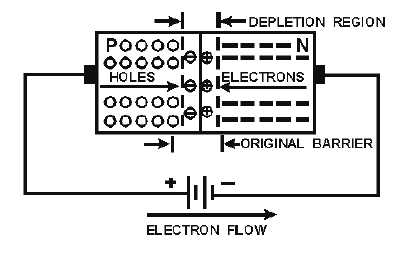1-21
Figure 1-18.—Forward-biased PN junction.
It is important to remember that in the forward biased condition, conduction is by MAJORITY
current carriers (holes in the P-type material and electrons in the N-type material). Increasing the battery
voltage will increase the number of majority carriers arriving at the junction and will therefore increase
the current flow. If the battery voltage is increased to the point where the barrier is greatly reduced, a
heavy current will flow and the junction may be damaged from the resulting heat.
REVERSE BIAS.—If the battery mentioned earlier is connected across the junction so that its
voltage aids the junction, it will increase the junction barrier and thereby offer a high resistance to the
current flow through the junction. This type of bias is known as reverse bias.
To reverse bias a junction diode, the negative battery terminal is connected to the P-type material,
and the positive battery terminal to the N-type material as shown in figure 1-19. The negative potential
attracts the holes away from the edge of the junction barrier on the P side, while the positive potential
attracts the electrons away from the edge of the barrier on the N side. This action increases the barrier
width because there are more negative ions on the P side of the junction, and more positive ions on the N
side of the junction. Notice in the figure the width of the barrier has increased. This increase in the
number of ions prevents current flow across the junction by majority carriers. However, the current flow
across the barrier is not quite zero because of the minority carriers crossing the junction. As you recall,
when the crystal is subjected to an external source of energy (light, heat, etc.), electron-hole pairs are
generated. The electron-hole pairs produce minority current carriers. There are minority current carriers in
both regions: holes in the N material and electrons in the P material. With reverse bias, the electrons in
the P-type material are repelled toward the junction by the negative terminal of the battery. As the
electron moves across the junction, it will neutralize a positive ion in the N-type material. Similarly, the
holes in the N-type material will be repelled by the positive terminal of the battery toward the junction.
As the hole crosses the junction, it will neutralize a negative ion in the P-type material. This movement of
minority carriers is called MINORITY CURRENT FLOW, because the holes and electrons involved
come from the electron-hole pairs that are generated in the crystal lattice structure, and not from the
addition of impurity atoms.

